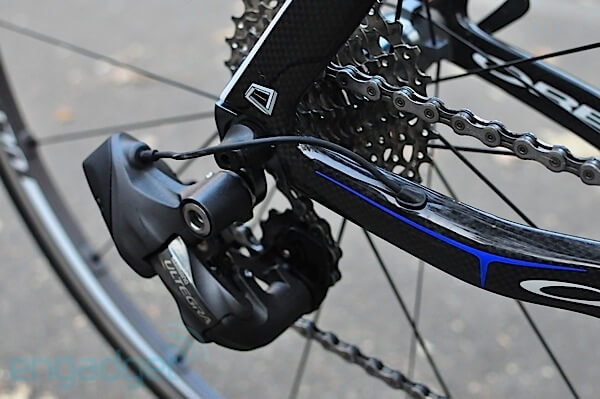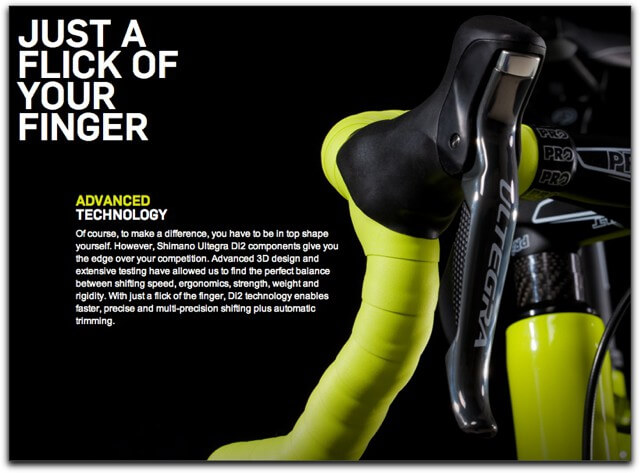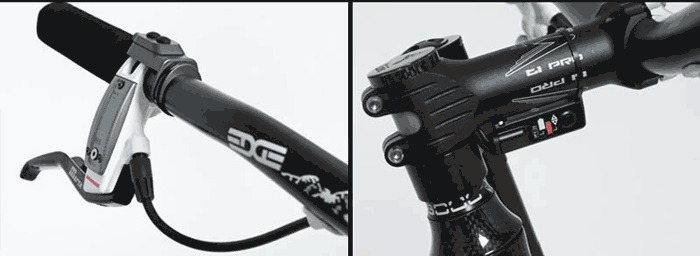Why Electronic Shifting on Bicycles will Continue to Grow in Popularity
Electronic gear-shifting is an innovative and relatively new system enabling cyclists to shift gears on their bicycle with electronic switches as opposed to traditional cable actuated mechanical control levers. These switches are connected by wires to a battery pack and small electric motor which drives the derailleur and switches the chain from cog to cog. Campagnolo and Shimano both currently make electronic shifting systems and they herald a new era for cycling, facilitating more rapid gear changes and less maintenance, due to the removal of Bowden cables and the ability for automated recalibration.
 Electronic shifting has grown in popularity significantly since it was first introduced in its current incarnation by Mavic with their “Zap” system over two decades ago. It has overcome its initial teething problems to provide an immensely reliable system which promises efficient cycling performance across terrains. Electronic shifting facilitates accurate and precise shifting for a thousand miles per charge and, unlike mechanical front shifting, it is not dependent on regular maintenance in order to maintain shifting consistency.
Electronic shifting has grown in popularity significantly since it was first introduced in its current incarnation by Mavic with their “Zap” system over two decades ago. It has overcome its initial teething problems to provide an immensely reliable system which promises efficient cycling performance across terrains. Electronic shifting facilitates accurate and precise shifting for a thousand miles per charge and, unlike mechanical front shifting, it is not dependent on regular maintenance in order to maintain shifting consistency.
This marks a significant turning point in the cycling industry. In the future, whether for professional or recreational use, more and more bikes will contain some form of electronic shifting. The invention of a viable electronic shifting derailleur system highlights the increasingly “old fashioned” elements of mechanical front shifting. Electronic derailleurs “know” the position of each sprocket and adapt movement of the front derailleur automatically to eliminate chain rub and require no additional input from the user, thus rendering the mechanical aspects of a front or rear derailleur as immaterial. The increasing technological capabilities of bikes will provide a more efficient and precision journey for all users. In the same way that cars have been technological revolutionized, bikes will follow a similar route. Nowadays, it is commonplace to have cars with automatic door locks and even keyless ignition. Electronic shifting on bikes will likely be regarded as similarly commonplace in the future.  While electronic shifting was originally only available at the very top of the line manual bicycles, both Shimano and Campagnolo have released lower priced electronic systems in the form of the Ultegra Di2 and the Athena EPS. Electronic systems are now available for a similar price to the better mechanical systems; Shimano’s Ultegra Di2 electronic system has a similar price to the mechanical Dura Ace offerings. There is rife competition within the market to provide a form of electronic shifting which is accessible for all. Manufacturers have become aware that whoever delivers the most efficient electronic shifting system will become the industry leader, highlighting the inevitable increase of electronic shifting systems in the future.
While electronic shifting was originally only available at the very top of the line manual bicycles, both Shimano and Campagnolo have released lower priced electronic systems in the form of the Ultegra Di2 and the Athena EPS. Electronic systems are now available for a similar price to the better mechanical systems; Shimano’s Ultegra Di2 electronic system has a similar price to the mechanical Dura Ace offerings. There is rife competition within the market to provide a form of electronic shifting which is accessible for all. Manufacturers have become aware that whoever delivers the most efficient electronic shifting system will become the industry leader, highlighting the inevitable increase of electronic shifting systems in the future.
Electronic shift systems for mountain bikes are now being introduced as well and, fundamentally, electronic shifting suggests a new paradigm within the cycling community. Electronic shifting is now standard on high-end electric bicycles, such as the $3,250 Smart Bike. Systematic improvements in its capabilities over recent years, as well as ongoing fervent competition between manufacturers to release the most effective design, suggests a potential surge in the market. Every aspect of modern society is becoming increasingly focused and integrated with technological enhancements. Therefore it is only natural that bicycles will follow suit in this electronic progression. In the next few years, there is enormous potential for a revolution in how we view bicycle shifting. Electronic shifting systems are rapidly becoming more commonplace and only time will tell the extent to which their popularity will impact the cycling industry.
This article was written by Bradley Taylor. Bradley is a freelance writer from Derby, England. He is a motoring enthusiast who loves writing about cars and everything automotive but he is versatile and also writes across a variety of other topics. You can stay connect with him on Google+ and follow his updates on Twitter.


